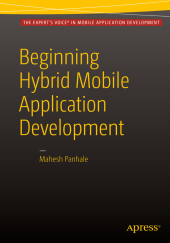 Neuerscheinungen 2015Stand: 2020-02-01 |
Schnellsuche
ISBN/Stichwort/Autor
|
Herderstraße 10
10625 Berlin
Tel.: 030 315 714 16
Fax 030 315 714 14
info@buchspektrum.de |

Mahesh Panhale
Beginning Hybrid Mobile Application Development
1st ed. 2015. xix, 222 S. 202 SW-Abb. 254 mm
Verlag/Jahr: SPRINGER, BERLIN; APRESS 2015
ISBN: 1-484-21315-7 (1484213157)
Neue ISBN: 978-1-484-21315-5 (9781484213155)
Preis und Lieferzeit: Bitte klicken
Create HTML5, JQuery, and CSS3-based hybrid applications and deploy them on multiple mobile devices, including on Android, iOS and Windows Phone. This kind of application development has the edge over native application development. Beginning Hybrid Mobile Application Development shows you how you can convert existing web application into mobile applications with minimal effort. You´ll see how hybrid applications can give many web applications a larger audience by making them available as mobile applications.
What You Will Learn
Understand the basics of hybrid application development
Discover the platforms and frameworks used for hybrid application development
Master hybrid application development using the available APIs
Access data in hybrid application
See the role of JSON versus XML in hybrid applications
Secure your code
Who This Books Is For
Mobile and web application developers.
Table of Contents
1. Introduction to Mobile Application Development (MAD)
1.1. History of MAD
1.2. MAD considerations
1.2.1. Front End Development
1.2.2. Back End Development
1.2.3. System Software
1.2.4. Mobile Application Testing
2. Getting Started
2.1. Mobile Application Development (MAD) Categories
2.1.1. Native Mobile Application Development (NMAD)
2.1.1.1. History
2.1.1.2. Pros & Cons
2.1.1.3. What Market Say?
2.1.2. Hybrid Mobile Application Development (HMAD)
2.1.2.1. Why HMAD?
2.1.2.2. History
2.1.2.3. List of technologies used in HMAD
3. Building blocks of HMAD
3.1. Architecture
3.1.1. Understanding OS runtime Vs Browser Engine
3.1.2. How Hybrid Application(s) work?
3.1.3. Difference between web application(s) & Hybrid Application(s)
3.2. Technology Framework Language(s)
3.2.1. HTML 5
3.2.1.1. Why HTML 5?
3.2.1.2. Basic(s) of HTML 5 & useful API(s)
3.2.2. JSON
3.2.2.1. XML Drawback(s)
3.2.2.2. What is JSON? Why JSON?
3.2.2.3. DOM 2.0 Change(s)
3.2.2.4. Who uses JSON?
3.2.3. Reincarnation of Java script
3.2.3.1. J Query Basics
3.2.4. Packaging Framework(s)
3.2.4.1. What is packaging framework
3.2.4.2. How does it work?
3.2.4.3. Popular framework(s):
3.2.4.3.1. IONIC
3.2.4.3.2. Phone GAP
3.2.4.3.3. Icenium
3.2.4.3.4. Kendo UI
3.2.4.3.5. Angular UI
3.2.4.3.6. Bonus
3.2.4.3.7. Sencha Touch
3.2.4.3.8. Intel XDK
3.2.5. Server side
3.2.5.1. HTTP Handler(s)
3.2.5.2. Service Oriented Architecture (SOA)
3.2.5.2.1. Web Service
3.2.5.2.2. WCF Service
3.2.5.2.2.1. REST Based Services
3.2.6. CSS 3
3.2.6.1. Responsive CSS
3.2.6.1.1. Bootstrap
3.2.6.1.2. Skeleton
3.2.7. Testing
3.2.7.1. Testing using browser
3.2.7.2. Testing on device(s)
3.2.7.3. Testing with packaging framework(s)
3.2.8. Deployment
3.2.8.1. Costing Consideration(s)
4. Creating first Hybrid Application
4.1. Choosing packaging platform
4.1.1. Consideration(s)
4.1.2. Setting up "Icenium" account
4.2. Authoring basic service returning JSON
4.3. Writing code snippet based on HTML5
4.4. Injecting J Query into the code
4.5. Decorating UI with responsive CSS
4.6. Early testing of hybrid application using browser
4.7. Packaging application first time using "Icenium"
4.7.1. Getting started with "Icenium"
4.7.2. Setting up Iceinum
4.7.3. Demo packaging
4.7.4. Running local test on device
4.7.4.1. Android
4.7.4.1.1. Developer Licensing terms
4.7.4.1.2. Step(s) for local device testing
4.7.4.2. iPhone
4.7.4.2.1. Developer Licensing terms
4.7.4.2.2. Step(s) for local device testing
4.7.4.3. Windows Phone
4.7.4.3.1. Developer Licensing terms
4.7.4.3.2. Step(s) for local device testing
5. HMAD: Internal(s)
5.1. Mobile device(s)
5.1.1. Architecture
5.1.2. OS
5.1.3. Application framework(s) platform(s)
5.2. How Hybrid Applications work on device(s)?
5.2.1. Browser context
5.2.1.1. Limitation(s) of browser context
5.3. Deep comparison: Native Vs Hybrid Application(s)
6. Data Access in HMAD
6.1. Exploring data access possibilities
6.1.1. WCF vs Web Service(s) vs Handler
6.2. Data Serialization techniques
6.2.1. JSON / XML / REST Serialization techniques on server side
6.2.2. Tip(s) to GET SET Data
6.2.3. Dos and Don´ts
6.2.3.1. GET or POST ?
6.2.3.2. Intrusion
6.2.3.2.1. Helper tools
6.2.3.2.1.1. Fiddler
6.2.3.2.1.2. Wire shark
6.2.3.2.1.3. Using browser based developer tools
6.2.3.2.1.3.1. Debug Trace Monitor JS Code
6.3. Code & Data security
6.3.1. Code Security
6.3.1.1. Bundling JS
6.3.1.1.1. Minify JS file
6.3.1.1.2. Obfuscate JS content(s)
6.3.2. Data security
6.3.2.1.1. Authentication Authorization on server side
6.3.2.1.2. Pass credential(s) through client side using JS
6.3.2.1.3. Protect JSON XML data
6.3.2.1.3.1. Encode or Encrypt?
6.3.2.1.3.2


